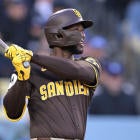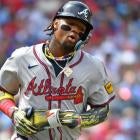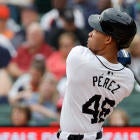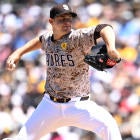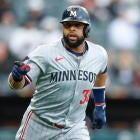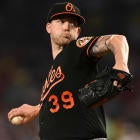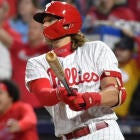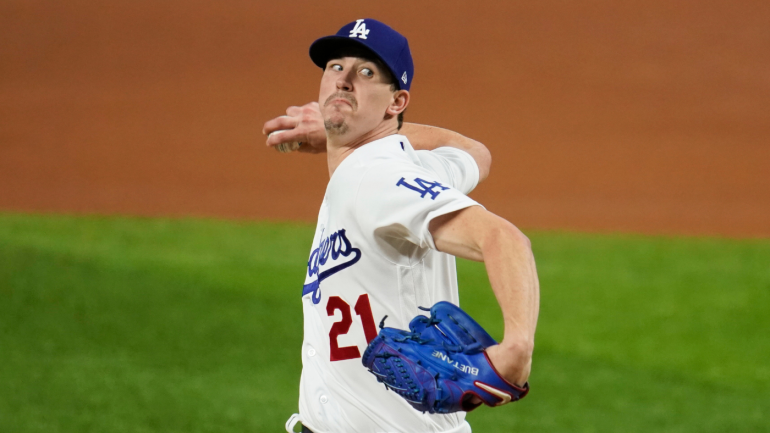
There's a right price for every player in a Fantasy Baseball draft, even for our bust picks. I would be thrilled to draft every single player on this list if I could name my price. Unfortunately, that's not how this game works. The draft isn't the only way to build a winning team, but your draft picks are the most valuable tools you have to build one, and you don't want to get them wrong.
You will, of course. There's no avoiding that. However, the difference between a champion and an also-ran can be hitting on one or two extra picks at the top of the draft. If you can avoid the early-round pitfalls or identify players with similar value available later in the draft, you can put yourself at an advantage.
I'm not saying all of these players will definitely disappoint in 2020 -- I'd bet more than a few of them end up making me look bad. But I've tabbed 10 players going inside the top 100 with risk factors or limitations that aren't being reflected in their price. I can't make you avoid any of them, but I can at least lay out the case for how things could go wrong.
Head on over to Spotify, Apple, or wherever else you consume podcasts to subscribe to Fantasy Baseball Today in 5.
Walker Buehler - ADP: 19.0
Buehler is probably the poster boy for "Right player, wrong price" in 2021. He's an excellent pitcher -- since the start of 2018, he ranks ninth in the majors in ERA and fifth in WHIP -- but he ranks just 45th in innings in that time. Sure, he spent part of 2018 in the minors, but he only threw 16 innings down there. Add that to his total plus his work in the postseason, and he has 433.2 innings pitched over the last three seasons -- 14 pitchers have surpassed that total innings count without including the postseason.
The Dodgers have been incredibly careful about Buehler's workload, and in 2020 he threw six innings just three times in 13 starts -- including only twice in five postseason starts. Coming off a shortened season, that shouldn't change too much, especially early on. Every pitcher will likely have a reduced workload in 2021, of course, which means 160 elite innings will likely never have more value for your Fantasy team than this season. However, it also means that those pitchers who won't have workload limitations will be even more valuable too -- 190 IP in 2021 will likely take up a greater share of your team's total than 200 does in most other seasons.
The problem, of course, is that Buehler is being drafted around pitchers we expect to provide both excellent production and high volume. Buehler is a very safe bet for elite ratios, but his best-case scenario probably isn't that different from Brandon Woodruff's, going off the board two rounds later, on average.
Also, The Fantasy Baseball Today Draft Guide is LIVE! It's a one-stop-shop to help anyone dominate their drafts that includes sleepers, breakouts, busts, rankings, analysis, tiers and more. The best part about it? It's free!

Fantasy Baseball Draft Kit
Your ultimate baseball draft guide
Dominate your Fantasy Baseball draft with our free Draft Kit, which gives you must-have positional and Top 300 rankings in a printable format. Plus track your draft with our lineup builder and salary cap tracker.
Thanks for signing up!
Keep an eye on your inbox.
Sorry!
There was an error processing your subscription.
Bo Bichette - ADP: 26.0
Bichette is hitting .307 with 16 homers and eight steals through the first 75 games of his career, so it's not hard to get excited about what he could do with a full season's work of playing time. However, if you're taking him at the end of the second round, you're basically allowing for no margin for error -- if he slips even a little bit from his pace so far, he's going to fall short of what you paid for him, and there's no guarantee he doesn't slip.
For one thing, while Bichette has been incredibly productive so far, he's missed a decent amount of time over the last few seasons with injuries: He had a broken hand in 2019 in the minors, suffered a concussion that ended that season early in the majors, and then he missed nearly a month with a knee injury in 2020. The good news is, it's three unrelated injuries, and both 2019 injuries especially just look like bad luck. But he does still have to prove he can hold up to the grind of a full 162-game major-league season.
And that includes how his production will hold up to the adjustments pitchers are inevitably going to make as they get more information about his weaknesses. Bichette has posted a .340 expected wOBA based on StatCast data, compared to a .370 mark for his career, so there's already room for some regression there, and there are some potential holes in his game to be exploited. Bichette hasn't shown much selectiveness at the plate, swinging at 41.0% of pitches outside of the strike zone (39.0% chase rate compared to 28.2% for the league as a whole), and he's also struggled with breaking pitches, posting an expected wOBA below .280 against them in both seasons. What happens if pitchers start throwing him more junk outside of the zone? Does he learn to be more selective, or does he keep chasing? Bichette isn't really an elite power hitter, so he'll be awfully dependent on a high batting average to create runs and get on base if he doesn't become more selective.
Ultimately, if you want to target upside at shortstop, there's no shortage of it. Tim Anderson goes two rounds later, and he's got just as much; Javier Baez does too, and he's four rounds later. Even at the same point in the draft, Xander Bogaerts is more proven, and it's hard to argue Bichette has more upside than what Bogaerts has shown. You're paying a premium for an unproven player at a position with an abundance of proven, high-upside players. Let someone else spend an early pick on the shiny new toy.
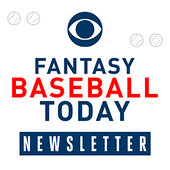
Fantasy Baseball Today Newsletter
Your Cheat Code To Fantasy Baseball
You're destined to gain an edge over your friends with advice from the award-winning FBT crew.
Thanks for signing up!
Keep an eye on your inbox.
Sorry!
There was an error processing your subscription.
Nolan Arenado - 29.6
Initially, I thought there might be an overreaction when Arenado was traded from the Rockies to the Cardinals and he might be a solid discount for 2021. Unfortunately, that just hasn't come to fruition yet, which means I'll be passing. It's not that I expect Arenado to be bad away from Coors Field -- his career road splits don't tell the whole story, and the likes of Matt Holliday and Larry Walker have left Coors and sustained much of their production with their new teams -- as much as I expect him to be a bit more of a normal third baseman for Fantasy. He'll still be a solid power hitter and source of batting average, but it'll be a lot harder for him to get to 40 homers or a .310-plus average.
It might be more like 30-35 homers and a .270-.280 average, and while there's absolutely nothing wrong with that, it's not a profile worth paying a premium for anymore. For example, Eugenio Suarez hit .277 with 83 homers between 2018 and 2019, and his 2020 batting average was driven by an unsustainably low BABIP. Arenado is going nearly 50 picks ahead of Suarez in ADP, but he's also going off the board ahead of Anthony Rendon, Alex Bregman, and Rafael Devers, too, and I'm just not sure he's that guy anymore. The ATC projections seem to agree with me:
Nolan Arenado | 29.6 | 147 | 30 | 84 | 95 | 1 | 0.271 | 0.34 | 0.486 | 0.826 |
Anthony Rendon | 34.4 | 145 | 28 | 92 | 98 | 2 | 0.289 | 0.386 | 0.515 | 0.901 |
Alex Bregman | 35.0 | 147 | 27 | 92 | 91 | 3 | 0.272 | 0.381 | 0.498 | 0.879 |
Rafael Devers | 41.2 | 148 | 31 | 96 | 100 | 4 | 0.281 | 0.336 | 0.514 | 0.849 |
Eugenio Suarez | 75.0 | 149 | 37 | 86 | 101 | 3 | 0.246 | 0.341 | 0.498 | 0.839 |
Take the names away from those projections, and Arenado might be at the bottom of the list. He certainly wouldn't be at the top.
Eloy Jimenez - ADP: 33.8
Here's another player I don't dislike, I just don't think his profile matches the price. Jimenez has one stolen base since 2016, so you can be pretty confident he'll be a zero there, and his lack of speed combined with his low OBP means he's probably not going to score many runs -- his per-150 game pace over two seasons is just 80.5, a number 75 hitters bested in 2019. So, he's really got to hit for both average and plus power to be a high-end Fantasy option, and there are questions about both to at least some extent.
Jimenez struck out 24.8% of the time in 2020 and 26.6% in 2019, so he's at a bit of a deficit there. The batted ball skills should prevent the average from cratering, but it might be tough for him to top .290 again in a full season without improving his strikeout rate by another few points. And, while he does hit the ball very hard -- 91st percentile in average exit velocity in 2020 -- Jimenez has a 49.2% groundball rate in the majors, the 17th-highest in that time. His elite quality of contact means he should continue to hit a high rate of his fly balls out, but if his 28.3% HR/FB falls to a still-very-good 23-25%, he might be more like a 30-homer guy rather than a 35-homer guy. Because Jimenez doesn't walk or run, the path to being an elite Fantasy option is a very narrow one. If he does slip, there may not be much separating him and someone like Michael Conforto (70.4) or Nick Castellanos (83.2).
Tyler Glasnow - ADP: 50.0
Glasnow has even more worrisome workload concerns than Buehler without being nearly as safe a bet to provide elite production. He'll rack up strikeouts at an elite rate when he does pitch, but he's thrown just 153.2 innings over the last two seasons, including the playoffs. That covers 31 starts, so that might be around the peak of what you could expect for Glasnow in 2021, given how the Rays use their starters. The 215 strikeouts in those 153.2 innings are excellent, but the 3.75 ERA and 1.13 WHIP don't stand out quite as much many drafters might hope.
Of course, if he did give you a 13-7 record, 3.75 ERA, 1.13 WHIP, and 215 K, that would be a pretty good season, even for a borderline fourth-round pick. The problem is, Glasnow has made those 31 starts in a span where even someone with workload concerns like Buehler has made 45, including equally deep postseason runs. He missed nearly four months with a forearm strain in 2019 and hasn't been quite as effective since. His walk rate has more than doubled from 4.9% in 2019 prior to the injury to 10.6%, and he has a 4.61 ERA 1.23 WHIP over his last 23 starts.
I would bet on Glasnow being much better than that, but you can't just ignore it either. If he was a safer bet to give you elite production despite a relatively low workload ceiling, but there's risk in the production as well. You could just wait one round and take Corbin Burnes or wait three and take Dinelson Lamet -- both of whom have similar profiles.
Josh Hader - ADP: 56.0
Closers got pushed down draft boards last year, but the higher-end guys are moving back up for 2021, and Hader's right there at the top of the heap. Hader is an excellent pitcher, obviously, and while there are signs of some slight skills decline -- including career-worst ERA, FIP, and SIERA -- the truth is, Hader is a bust candidate mostly because he's the first closer off the board. The bar is incredibly high at that point in the draft -- you're passing on potential No. 1 SPs like Corbin Burnes, Hyun-Jin Ryu, Carlos Carrasco, and Stephen Strasburg, not to mention countless impact bats -- so Hader really can't afford to slip and lose the job or get hurt. Hader makes sense as the No. 1 closer, but it's just not a position I'm comfortable reaching for. Getting an elite closer isn't a priority unless I'm going for an RP-heavy build in a head to head categories league.
Cavan Biggio - ADP: 60.4
With 24 homers and 20 steals in 159 games, Biggio has a profile that is very well suited to Fantasy production, but he's operating in incredibly thin margins. Biggio ranked in the 26th percentile in average exit velocity and 13th percentile in hard-hit rate, while his average home run distance was just 379 feet -- the 10th-shortest in baseball. And, while Biggio is pretty quick with an average sprint speed ranking in the 72nd percentile in 2020, he's certainly not elite in speed. Biggio has gotten the absolute most out of his skill set so far by being incredibly efficient on the basepaths (20 for 20 on steal attempts), incredibly patient at the plate (16.1% walk rate, third-lowest overall swing rate on all pitches since 2019), and an extreme flyball hitter (fourth-lowest groundball rate).
He certainly could be a 20-20 guy with 100-plus runs in this Blue Jays lineup, but he doesn't have much wiggle room. Biggio had a 79% success rate in the minors, where stealing bases is easier, on the whole, and he's hit a ton of wall-scraper home runs. If a few of those home runs fall just short of the fence and the potentially de-juiced ball robs him of a few more, and he steals bases at more of a 75-80% clip, is he a 16-homer, 16-steal guy with a .240 average? Isn't that Nick Senzel with better job security?
Trent Grisham - ADP: 64.4
Grisham is actually a lot like Biggio in a lot of ways, so perhaps it's no surprise I'm down on both. A lot of the appeal for Grisham comes from the power/speed combination he brings to the table, and the good news is, the Padres seem a lot more willing to let him run than the Brewers were; he attempted 11 steals in 59 games, after just one in 51 games in 2019 in MLB and 32 in 255 games between the majors and minors in 2018 and 2019. Grisham has the foot speed to be a 25-plus steals guy, and if the Padres let him, the path to living up to this price is a lot clearer.
However, the bat is still a pretty big question. Grisham was a career .255/.376/.415 hitter in the minors, and he's sporting a very similar .243/.342/.437 line in 110 major-league games. And his apparent 2020 breakthrough was very front-loaded: After homering three times in Game 29, he was hitting .271/.381/.533; he hit just .231/.323/380 in the final 30 games. The Padres moved him down to ninth in the order against lefties late in the season, and while his .737 career OPS against them isn't bad, his 33.9% strikeout rate and .370 BABIP suggest he might not be quite that good.
Again, if Grisham is a 20-25 SB player, it won't matter all that much how well he hits. However, if the bat isn't a sure thing and the steals slip -- either because he slips in the order or just doesn't run as much -- all of a sudden, the profile doesn't look quite as promising. As it is, I'm not sure I wouldn't rather have Byron Buxton than Grisham straight up, let alone five rounds later.
Teoscar Hernandez - ADP: 77.8
When I'm trying to figure out if a player truly took a step forward in 2020 or just had a hot streak, one of the things I'm really looking for is a sign that they added some new skills to their game. In Hernandez's case, I'm not sure he did. He's always been a super-athletic player who hits the ball really hard with bad plate discipline, and he looked like that guy in 2020. In some ways, he was better -- his average exit velocity and hard-hit rate jumped from "very good" to "elite" and he was more aggressive as a base runner -- but his plate discipline was actually worse than ever, as he swung at pitches out of the strike more than often while also posting his lowest swing rate on pitches inside the strike zone.
Maybe the jump in batted-ball quality matters more, but it's a bit hard to buy into that approach being sustainable over the course of a full season. And he didn't really sustain it in 2020, as this graph of his rolling average exit velocity for every 25 batted-ball events over the last three seasons highlights:
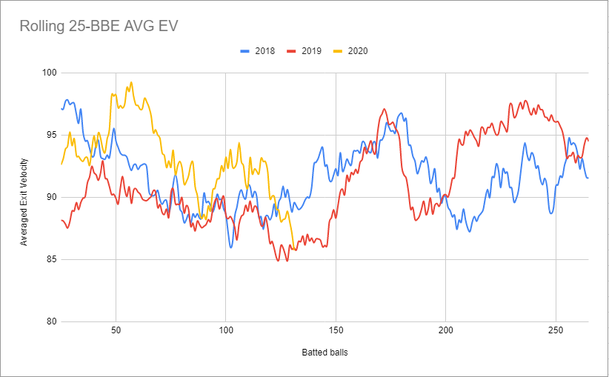
The peak in 2020 is a bit higher than previous seasons, though not that much higher than it was in 2018, it fell back to previous levels pretty quickly, while his rolling average over the final stretch of the season was nearly as low as ever before. You can something similar in this graph of his average OPS over the last three seasons:
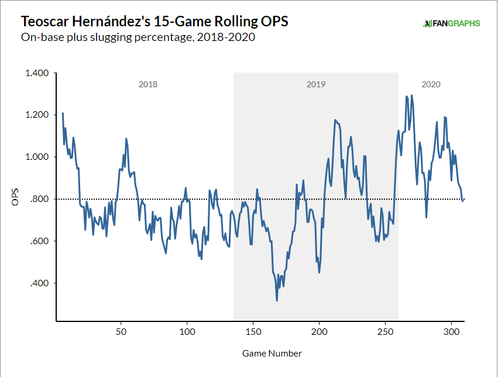
Again, slightly higher peak, but not a total outlier. What it mostly looks like is he got off to a really hot start and the season ended before the regression hit, though it is worth noting that spike in the second half of 2019 -- it's possible 2020 was a continuation of that, though again, there still wasn't much of a change in the underlying approach or skill set to point to in either example.
Hot and cold streaks happen for every player, but when you're dealing with small sample sizes, the outliers can impact the overall numbers a lot more. Hernandez should be a solid source of power with the occasional stolen base thrown in for good measure, but I'm not convinced Hernandez has become a totally different player.
Dinelson Lamet - ADP: 85.6
Wait, how can Lamet be a bust if I suggested him as a similar player to Tyler Glasnow at a cheaper price? Well, Lamet is actually even riskier than Glasnow. He was incredible in 2020 -- 2.09 ERA, 12.1 K/9, career-low HR/9 and BB/9 -- but his season came to an early end with a biceps injury in his throwing arm, one that required a PRP injection and has limited his work in the offseason.
Lamet has thrown 142 innings since his return from Tommy John surgery in 2019, so there's clearly a lot of injury risk here, and there's also performance risk: He had a 4.07 ERA in 2019 and a 4.57 mark in 2017, and he's always gotten hit pretty hard. He's a two-pitch pitcher, and his fastball isn't that good, so pretty everything Lamet does relies on his slider. He threw it a career-high 53% of the time in 2020, and it's as fair to wonder if that was a sustainable approach as it is to wonder if he can be a difference maker without that approach.
Lament could put up similar numbers to Glasnow, but that goes both ways -- neither is exactly guaranteed to be dominant. In Lamet's case, it also comes with even more risk.















